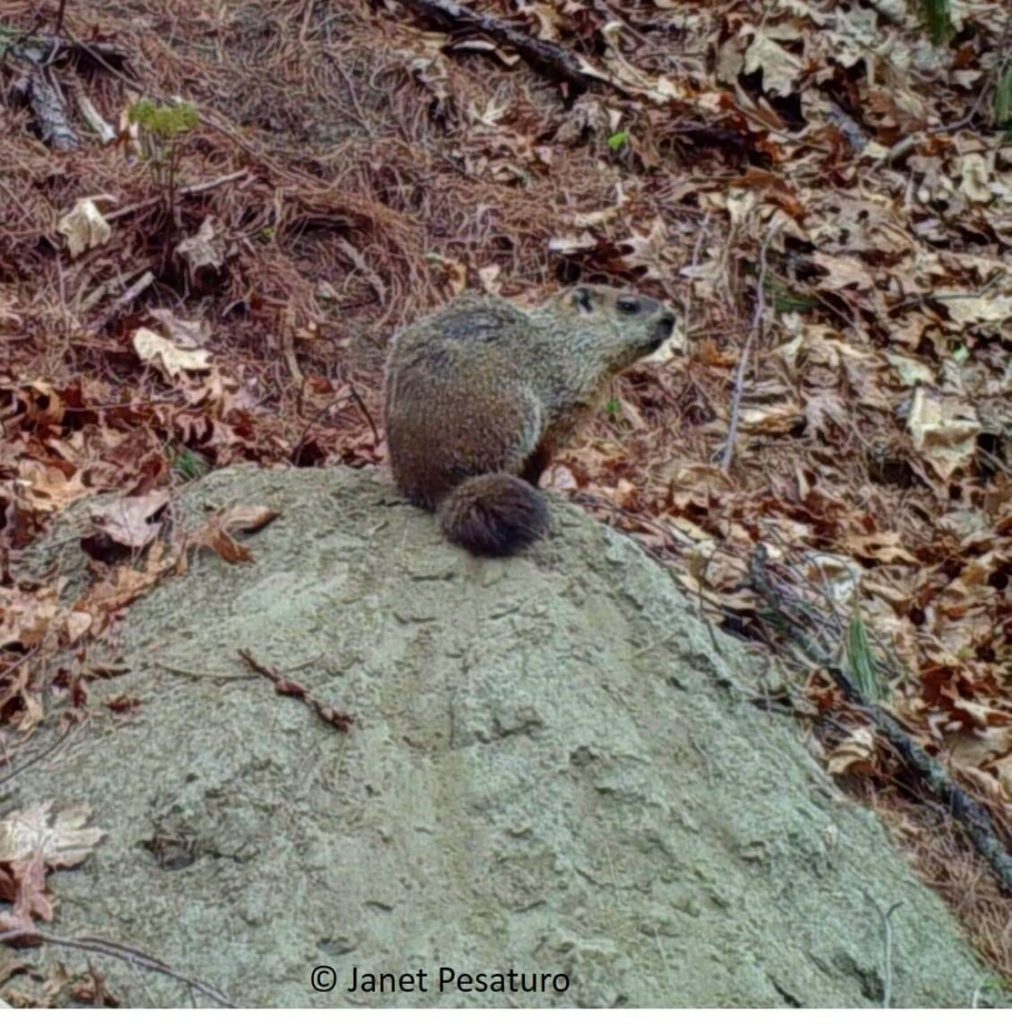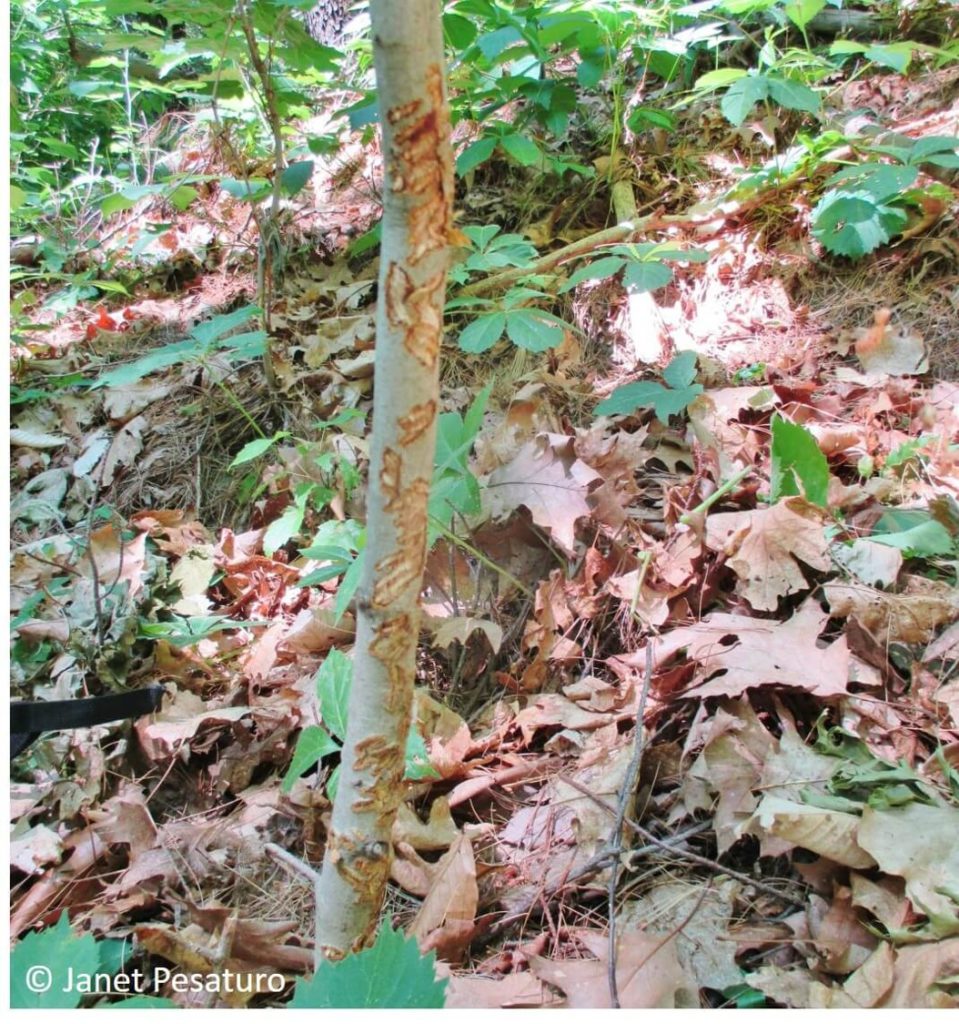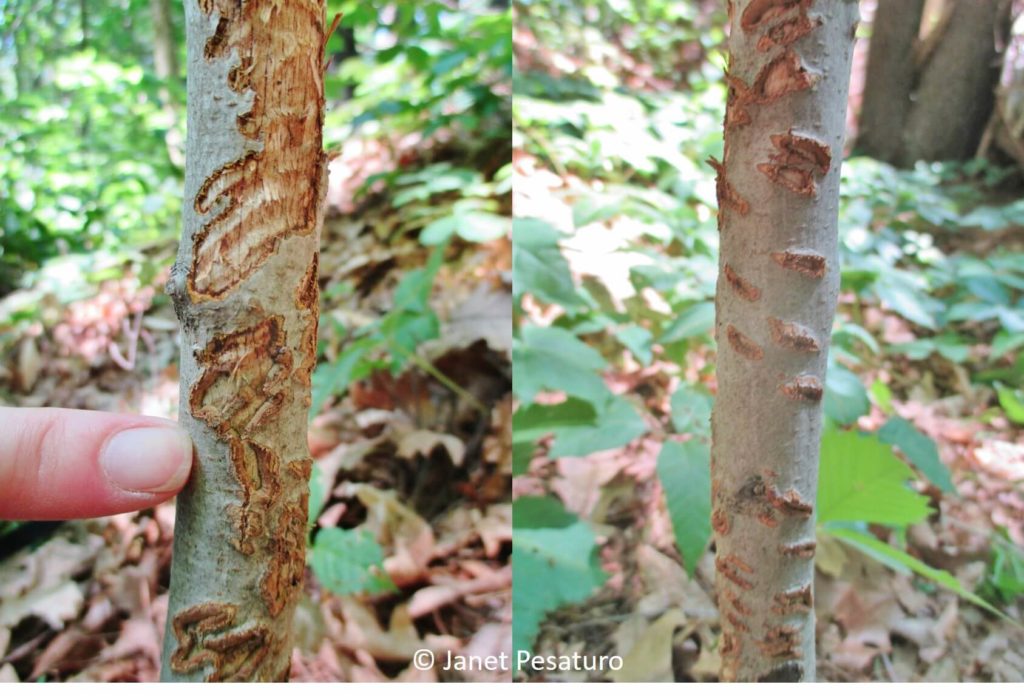Woodchuck Scent Marking: Video

This is the female woodchuck sitting on the throw mound near the mouth of the burrow. She is smaller than the male and in this case happens to have a fluffier tail, making it easy for us to distinguish the two.
Woodchucks (Marmota monax) have sweat glands near the corners of the mouth which emit a pungent odor. The animals are well known to rub their cheeks on trees, roots, and stones near the den, thus depositing their scent. Groundhogs often gnaw before rubbing, and this activity seems unrelated to feeding, for bits of nutritious cambium can be found uneaten at the base of the tree. Further, the rubbing and gnawing correlate closely with breeding behavior. They are much more common during the breeding season, and almost always occur within 20 feet of the den. One question is why they often gnaw where they rub, since rubbing alone deposits scent. Some speculate that gnawing to expose the wood is a way to facilitate retention of scent.
Whatever the reason for it, the gnawing can do significant damage to fruit trees, but research has shown that application of predator scent, such as bobcat urine, to the tree trunks greatly reduces woodchuck gnawing.

Beech sapling near the den, with abundant sign of gnawing, all within 18 inches of the ground.
Susan and I currently have cameras stationed at an active den, and have captured numerous instances of whistlepig (another nickname for Marmota monax) scent marking. As explained in Susan’s introductory woodchuck post, we can distinguish male from female and, quite interestingly, all of the gnawing and rubbing we have seen so far has been the work of the male. But we haven’t been able to find mention in the literature of differences in scent marking behavior between the sexes.

Closeup of beech sapling which the male woodchuck has been scent marking. The side facing the den is on the left. At right is the side facing away from the den.
Watch the video below. It shows several instances of the male woodchuck scent marking by rubbing 3 different twigs, and finally gnawing and rubbing a beech sapling, all near the den. The sapling bears obvious teeth marks on the side facing the den. The opposite side of the sapling has some single marks, which I think could be claw marks created while the groundhog wrapped his fingers around the sapling as he gnawed. Or are those teeth marks produced by occasionally reaching his head around and biting? What do you think?
Woodchuck Scent Marking Video
As for the female? It’s entirely possible that she has been scent marking near this den, but outside of the camera detection zone, or even at a different den. Groundhogs may have multiple holes, and, in fact, I don’t believe the hole at which we have our cameras stationed, is the entry to the natal chamber. The male has been doing most of the excavation at this particular hole, and one video clip shows the female running off with a mouthful of leaf litter, as if she was carrying material for the nest chamber to a different den. I wonder if the den in our photos and videos is just a “love nest” for this couple.
But it remains to be seen. Last week I mounted a camera at another hole, about 100 feet from this one, and we will see what happens at both of these dens over the coming weeks.
Sources:
Hebert, P. and J. Prescott. “Etude du Marguage Olfactif Chez la Marmotte Commune (Marmota monax) en Captivite.” Canadian Journal of Zoology. 61 (1983): 1720-1725.
Ouellet, J. and J. Ferron. “Scent Marking Behavior by Woodchucks (Marmota monax).” Journal of Mammalogy. 69, no. 2 (1988): 365-368.
Swihart, R. K. “Modifying Scent-Marking Behavior to Reduce Woodchuck Damage to Fruit Trees.” Ecological Applications. Vol. 1, No. 1 (1991): 98-103.
Walro, J. M., P. T. Meier and G. E. Svendsen. “Anatomy and Histology of the Scent Glands Associated with the Oral Angle in Woodchucks.” Journal of Mammalogy. 64, no. 4 (1983): 701-703.

You could try to assign teeth or claw damage to the back side of the sapling by comparing the tool marks on the two sides. I imagine that teeth and claws would make different-looking cuts.
Keep recording. Perhaps something other than the male did the back-side vandalism.
I think they do look different. What struck me is that most of the marks on the backside were single and more superficial than the gnaw marks on the front. However, the marks on the upper portion of the backside are deeper and paired. I think those upper marks were made by the paired incisors, while the single cuts lower down were made by claws. It’s hard for me to imagine the single marks made by incisors, but I’ve still got the camera in place, so maybe future videos will make all this clearer.
“Whistlepigs”…!
I LOVE the fun facts I learn (and watch on film) through you Janet. Thank you!
I’ll be honest, Pat, Whistlepig was a new term for me, too. I don’t think too many people here in New England use that term for woodchuck.